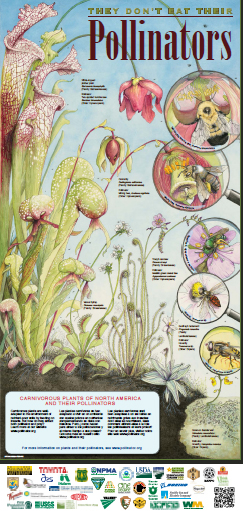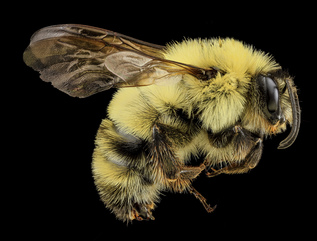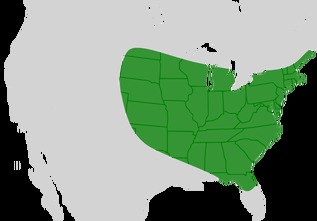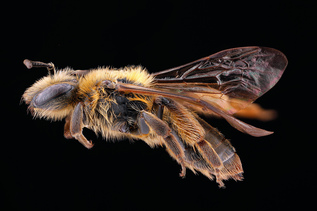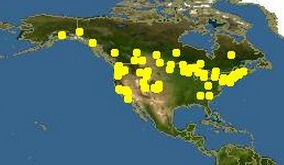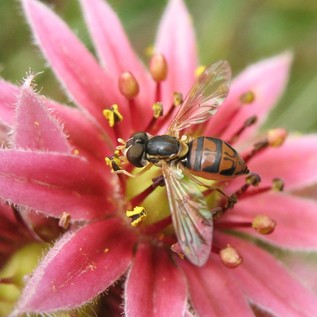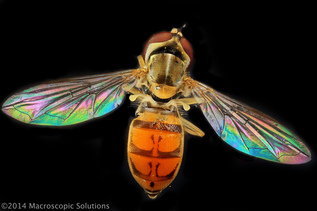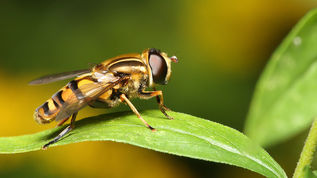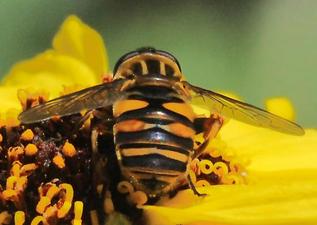The Pollinators
Overview
Pollination occurs when pollen is moved within flowers or carried from flower to flower by wind, water, or pollinating animals. Almost 90% of all flowering plants rely on animal pollinators for fertilization, and about 200,000 species of animals act as pollinators. Of those, 1,000 are hummingbirds, bats, and small mammals such as mice. The rest are insects like beetles, flies, bees, ants, wasps, butterflies and moths. Plants can also be pollinated by wind and water. The transfer of pollen in and between flowers of the same species leads to fertilization, and successful seed and fruit production for plants. Pollination ensures that a plant will produce full-bodied fruit and a full set of viable seeds.
Worldwide, approximately 1,000 plants grown for food, beverages, fibers, spices, and medicines need to be pollinated by animals in order to produce the goods on which we depend. In the United States, pollination by honeybees and other insects produces $40 billion worth of products annually.
Learn more about the pollinator lifecycle here and how you can help protect them here!
Pollinator Identification
1. Two-spotted Bumble Bee - Bombus bimaculatus (Hymenoptera)
- Geographic Distribution: Eastern North America, Ontario to Florida and as far west as Mississippi.
- Habitat: Meadows or gardens with a diversity of flowers.
- Size: Medium-sized bumble bee. Queen - length 17-22 mm, abdomen 8.5-10 mm wide. Worker - length 11-16 mm abdomen 5-6.5 mm. Male – length 13-14.5 mm, abdomen 6-6.5 mm wide.
- Identification: Thorax predominantly yellow, with a dark spot in the middle, abdomen yellow at the top segment, black below.
- Pollinates: White-topped Pitcher Plant - Sarracenia leucophylla (Sarraceniaceae)
- Other Plants Commonly Visited: Thistles, vetches, roses, golden rod, mints.
- Encyclopedia of Life: http://eol.org/pages/1065374/overview
A widely-distributed species in the eastern United States, this bee has a medium-long tongue and visits a wide range of flowers for nectar and pollen. They typically nest below ground and not normally in the wet areas where many carnivorous plants are found, but they are strong flyers and may forage up to 2 miles away from their nest. This species name refers to the two distinctive yellow markings on the abdomen.
|
back to the top
2. Mining Bee - Andrena nigrihirta (Hymenoptera)(Sarraceniaceae)
- Geographic Distribution: Northern U.S. and Canada.
- Habitat: Nests on thinly grassed slopes of ground. Nests are tunnels in the ground 8-12 inches long with side branches off the main tunnel.
- Size: Females - length 10 mm; males resemble females but are slightly smaller.
- Identification: Black with sparse gray hairs, especially on abdomen, some black hairs on face of male.
- Pollinates: Cobra Lily, California Pitcher Plant - Darlingtonia californica (Sarraceniaceae)
- Other Plants Commonly Visited: Willow, buffalo berry, wild plum, strawberry and pasque flowers.
- Encyclopedia of Life: http://eol.org/pages/1046847/overview
This is an early spring species of bee occurring late April to early May and as a result is an important pollinator of fruit bearing plants. This species has short, triangular tongues about one-third the length of long-tongued bees of a similar size. The forewings are long and pointed towards the top. Pollen is collected on the hind legs but largely near the body with large collections on the rear thorax and base of legs. They have been referred to as “sand bees” but can be found in more dense clay and silt soil. This genera as a whole is difficult to find and identify due to their grassy nest locations and the slight differences among the many species.
|
back to the top
3. Metallic Green Sweat Bee - Agapostemon sericeus (Hymenoptera)
- Geographic Distribution: Eastern North America, Manitoba to Florida and as far west as Nebraska.
- Habitat: Ground nesting in soil burrows or sometimes rotting wood.
- Size: Length 12 mm.
- Identification: Metallic green head and thorax. Females have a metallic green abdomen with white hair bands in-between segments. Males have black and yellow abdominal bands.
- Pollinates: Tracy’s Sundew - Drosera tracyi (Droseraceae)
- Other Plants Commonly Visited: Generalist species often seen visiting asters, roses, peas and heathers.
- Encyclopedia of Life: http://eol.org/pages/2742839/overview
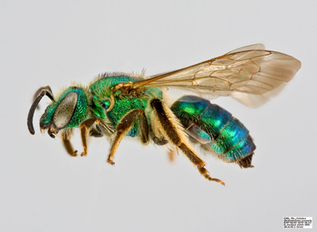
(female)
|
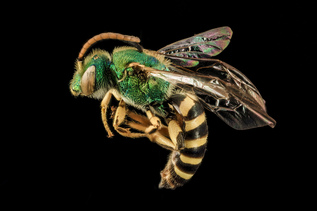
(male)
|
This species is a solitary bee with a single adult bee per nest. Agapostemon species are differentiated from other metallic green bees by the hind tibia being equal to or exceeding the tarsi in length. There are about 40 species in this genus. Agapostemon are commonly called “sweat bees” but unlike the related Halictus and Lasioglossum genera, they are not attracted to human sweat.
|
back to the top
4. Hoverfly - Toxomerus sp. (Diptera)
- Geographic Distribution: The genus is found in North, Central, and South America.
- Habitat: Meadows or gardens with flowering plants.
- Size: Medium-sized fly.
- Identification: A combination of black and yellow stripes, only one set of wings, and large compound eyes that nearly cover the head. Males can be distinguished from females with their eyes meeting at the top of the head.
- Pollinates: Godfrey's Butterwort, Violet Butterwort - Pinguicula ionantha (Lentibulariaceae)
- Other Plants Commonly Visited: Species in this genus visit flowers of a large number of plant families.
- Encyclopedia of Life: http://eol.org/pages/80861/overview
Toxomerus is a large genus with many species, distributed throughout the New World. The color patterns typically mimic wasps, which provide them some protection from predators. They are active and agile flyers, and can hover (hence the common name) in place for extended periods. They don’t have long tongues so can only collect nectar from relatively shallow flowers, but they will also visit flowers to eat pollen. Hover flies mimic bees and wasps.
|
back to the top
5. Hoverfly - Helophilus intentus (Diptera)
- Geographic Distribution: United States and Canada.
- Habitat: Meadows or gardens with flowering plants.
- Size: Medium-sized fly.
- Identification: Black horizontal stripes on the abdomen on a yellow background, and vertical stripes on the thorax.
- Pollinates: Common Bladderwort - Utricularia macrorhiza (Lentibulariaceae)
- Other Plants Commonly Visited: Some Asteraceae (sunflower family).
- Encyclopedia of Life: http://eol.org/pages/749009/overview
This species, as is true for many in the family Syrphidae, is considered a mimic of the warning color pattern of yellow and black found on wasps such as yellow jackets. They are active and agile flyers, and can hover (hence the common name) in place for extended periods. They are common flower visitors, collecting nectar and eating pollen, but not much is known in detail about their importance as pollinators or even the diversity of flowers they visit.
|
back to the top

